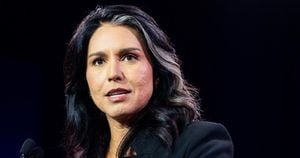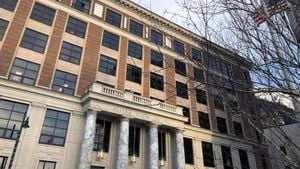U.S. retail sales surged unexpectedly in July, making many optimistic about the economy's resilience. According to the Commerce Department, retail sales jumped by 1% from June to roughly $709.7 billion, marking the largest increase since January 2023.
Analysts had initially predicted only a modest rise of 0.3%, but sales were primarily boosted by the recovery of automobile sales after pandemic-induced supply chain disruptions. Auto dealerships reported strong sales, which contributed significantly to the overall sales boost.
Consumer spending trends reveal intriguing patterns, with motor vehicle sales rising significantly by 3.6%. Likewise, grocery store sales saw increases of 1.0% as families adjusted their budgets to handle inflation.
Despite fears of rising interest rates and inflation, consumers appeared undeterred. Kathy Bostjancic, Nationwide's chief economist, remarked, "Consumers continue to spend at a solid clip, even if they are more budget-conscious and seeking more bargains."
This positive data is critical as the Federal Reserve debates its monetary policy. Economists suggest high retail sales figures could influence the direction of interest rate cuts, showcasing potential caution as future decisions loom.
Interestingly, last month, retail data was adjusted downwards, indicating June sales actually fell by 0.2%. Observers noted this decline might have been due to temporary setbacks like cyberattack-related disruptions affecting auto sales.
Examining July's retail sales closely, the underlying data shows mixed results. Excluding vehicles and parts, non-auto sales rose by 0.4% compared to June, signaling steadier consumer habits.
Michael Pearce, economist at Oxford Economics, stated, "The jump in headline retail sales largely reflected the bounce back in auto sales as cyberattack-related disruption faded."
Shifts in consumer behavior reveal increased caution, with many shoppers becoming more frugal. Bostjancic noted, "The consumer is becoming more frugal; they have drawn down their savings and have increasingly tapped credit whilst facing high costs, particularly for services."
Surprisingly, sectors like electronics and appliances have also seen positive trends alongside the retail revival. The uptick suggests glimmers of hope amid rising living costs and financial pressures resulting from high-interest rates.
Consumer behavior analysts predict this trend may influence retailers' pricing approaches moving forward. Shoppers are evidently becoming more selective, keeping their eyes peeled for deals and discounts as they navigate these uncertain economic waters.
Looking to the future, market experts will keep a close eye on consumer spending, which is often deemed the lifeblood of overall economic health. Sustained high spending levels could alleviate recession fears and influence potential policy modifications.
So, what's the real impact on everyday Americans? Consistent retail sales potentially signal consumer confidence and might reflect financial adjustments made to cope with increased living costs.
Experts are also monitoring if these spending patterns will persist as the months progress. The July retail surge raises intriguing questions about how consumer habits will align with the economic strategies and monetary policies established by the federal government.
The steady rise of retail activity highlights the delicate interplay between consumer confidence and inflation pressures. Policymakers must swiftly determine the best course of action to manage the complex dynamics of the current economic climate.
Industry analysts suggest scrutiny will only intensify as the Fed heads toward critical decisions this financial quarter. The combination of retail successes and cautious consumer behavior might be pivotal as central bank officials contemplate their future rate cuts.
Central to this narrative is the story of U.S. consumer resilience, where the July data illustrates consumers' ability to navigate spending effectively, buoying retail outlets amid economic turmoil.
Meanwhile, consumer sentiment appears to be influenced by the political climate. Recent polling indicates heightened optimism among Democrats, particularly concerning Vice President Kamala Harris’ prospects compared to Donald Trump.
The University of Michigan's consumer sentiment index climbed from 66.4 to 67.8 this month. While Americans’ expectations for the future surged, assessments of current conditions dipped slightly, reflecting mixed emotions.
Interestingly, 41% of those surveyed felt Harris was the better economic candidate, whereas 38% favored Trump. This marks a shift from previous sentiments when Trump enjoyed more advantageous ratings on economic leadership.
Joanne Hsu, the director of consumer surveys at the university, believes these sentiments will vary as new polls emerge. Both sides of the political spectrum indicated their economic outlook hinges on the election's outcome.
This sentiment index has rebounded since hitting rock bottom at 50 during June 2022, amid soaring inflation. Despite improvement, it remains below healthier historical levels, having typically registered in the 90s before COVID-19 upended the economy.
"Consumers are still pretty glum overall by historical standards, but sentiment is on an improving trend," noted Carl Weinberg, chief economist at High Frequency Economics. This sentiment matters because consumer moods play a significant role—accounting for about 70% of U.S. economic activity.
Even with concerns about rising prices, spending seems steady, contributing to economic growth at 2.8% annually from April to June. This positive trend appears to be continuing, as evidenced by the reported 1% increase from June to July this year.
The Federal Reserve has taken measures to combat inflation by raising benchmark interest rates 11 times between 2022 and early 2023, now sitting at the highest point since 2000. Nonetheless, inflation has significantly decreased from its peak at 9.1% last June to just 2.9% recently, nearing the Fed's 2% objective.
There's widespread anticipation of possible rate cuts at the next Federal Reserve meeting, aimed at fostering continued economic growth. The expectation of more manageable price increases is encouraging for the Fed, especially since inflation has settled within acceptable bounds.
Overall, consumer expectations for future inflation have lessened. This month, surveys indicated consumers expect prices to rise by 2.9% over the next year—a significant change from mid-2022, when expectations hovered around 5.3% growth.
These expectations are critical since they can influence consumer behavior. If shoppers believe prices will rise sharply, they are more prone to purchase items immediately, which can then drive prices upward.
Hsu warns, "If inflation expectations are high, it can be self-fulfilling, and policymakers want to avoid this situation at all costs." Therefore, the trend toward smaller expected price increases is welcomed news among inflation-fighting policymakers.



